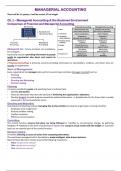Summary
Summary Managerial Accounting - Telfer, uOttawa
- Course
- ADM 2341 (ADM2341)
- Institution
- University Of Ottawa (U Of O )
This course introduces students to the role of management accounting, as distinct from financial accounting, in the decision-making process. Major topics of the document include: the determination of the costs of products and services, cost behaviour, relevant costs, standard costs, budgeting, resp...
[Show more]



